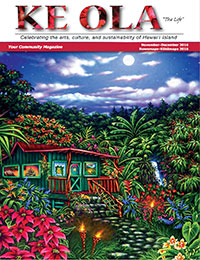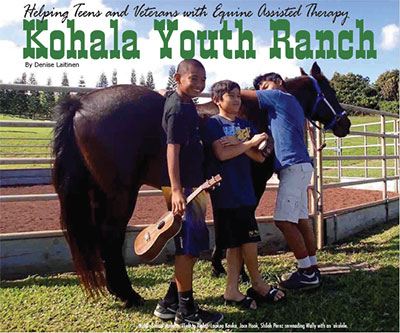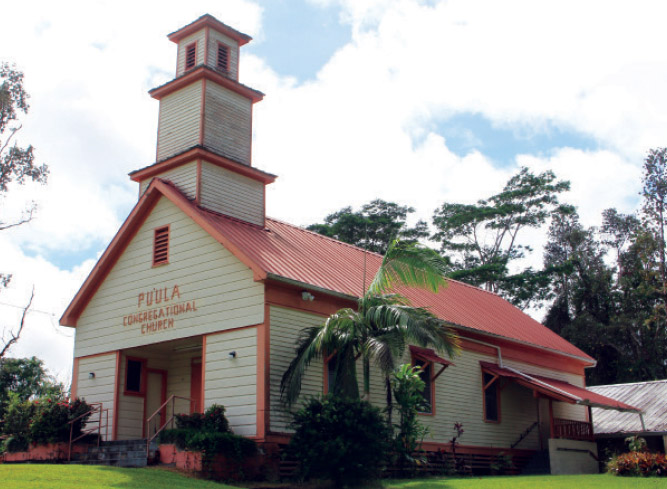100 Years of Giving: Hawai‘i Community Foundation Celebrates a Century of Helping Hawai‘i Island
 By Denise Laitinen
By Denise Laitinen
Nonprofit organizations can impact our lives in so many ways that we aren’t always aware of how much we benefit from their services.
For 100 years, Hawai‘i Community Foundation (HCF) has been helping nonprofit organizations statewide, including dozens on Hawai‘i Island. Yet, most people are unaware of the breadth and depth of the community work done by HCF.
In the past five years, Hawai‘i Community Foundation has distributed more than $18 million in grants and scholarships to nonprofit groups across Hawai‘i Island. Funds from HCF have touched nearly every aspect of life on our island from helping support community hospitals, to providing financial literacy training to the homeless, to offering more than 200 different scholarships to island students.
Hawai‘i Community Foundation got its start back in 1916 on O‘ahu when the Hawaiian Trust Company formed the Hawaiian Foundation, in order to distribute funds that weren’t tied to someone’s will or trust to those in need.
Business and community leaders who want to give back to the community, bequeath money in their estate or make donations to the foundation that go into a fund, which in turn are donated to local nonprofit organizations and scholarship programs.
HCF works with donors of all sizes—some are individuals who want to connect with reputable charities or a family that wants to give back to the community while honoring the family name. Others are collaborative funding partnerships, like the East Hawai‘i and West Hawai‘i Funds.
HCF handles all the administrative, financial, and grants services, making it easier for people to contribute to a charity of their choice.
For decades, HCF quietly went about supporting various nonprofit groups on O‘ahu and the neighbor islands. For instance, in 1963 Mary Wilson Crawford left a legacy gift to establish a fund supporting Hawai‘i Preparatory Academy and two arts program on O‘ahu: the Honolulu Symphony and Honolulu Academy of Arts.

Three years later, Alice Soper made a sizable donation to the Foundation that enabled HCF to provide grants for many years to organizations on Hawai‘i Island that help children with special needs and the elderly. Her donation enabled HCF to provide grant funding to organizations like the Bay Clinic and Hawai‘i Island Adult Day Care.
The Foundation underwent major changes in 1987 when it was given its current name, Hawai‘i Community Foundation, and restructured with the creation of a Board of Governors and multiple trustees.
Hawai‘i Island residents have been involved in HCF’s Board of Governors from its inception with Robert Fujimoto of Hilo appointed to the board in 1987.
Foundation leaders at the time saw that a large public foundation could amplify its philanthropic efforts greater than many smaller funds. Shortly thereafter, they created donor advised funds, creating grant programs that connected the interest of a donor with specific needs in a community.
For example, in 1996, Oscar and Ernestine Armstrong established a donor advised fund that supported organizations such as Family Support Services of West Hawai‘i, The Salvation Army, the Boy Scouts, and the Food Basket.
Philanthropic efforts on Hawai‘i Island increased even more in 1990, when a group of West Hawai‘i community leaders consisting of Gloria Blum, Virginia Isbell, Roberta Transue, Alan Wilcox, and Bill Wong created the West Hawai‘i Fund and “Monty” Richards of Kahua Ranch was appointed to the HCF Board of Governors.
Hawai‘i Community Foundation’s impact on Hawai‘i Island really kicked into high gear when the organization opened its first office on island in 2000.
“Like so many O‘ahu-based entities, the neighbor islands were beneficiaries to a degree of giving, but it was all anchored on O‘ahu,” says Lydia Clements, HCF’s Director of Neighbor Islands Philanthropic Services, describing the early decades of HCF’s community work.
“Our work truly became statewide, when we created the neighbor island offices back in 2000,” adds Lydia. The first HCF neighbor island office opened in Waimea in 2000, with additional offices on Maui and Kaua‘i following soon after.
“Before that we were statewide in mission, but we did not have full-time staff on the ground in the neighbor island communities. All of us on neighbor islands know that you need people who are active in the community to really understand what a community’s needs are.”
A Hilo office and additional Hawai‘i Island staff were added in 2015 and they now have four full-time staff between the two Hawai‘i Island offices.
During the past century, Lydia says the Foundation’s biggest accomplishments have been in the years since they opened the Waimea and Hilo offices.
“Because we’ve been around for a while and we have four full-time staff on island, people come to us to figure out what’s really needed in the community and how to make the impact that they want to make.”
All total, Hawai‘i Community Foundation has 88 funds specific to Hawai‘i Island, 31 of them scholarship funds. HCF manages the different funds, ensuring that donations are invested prudently to make long-lasting impacts.
Some of the funds are designed to support specific fields, such as environmental issues or education, while others are more general. Advisory committees comprised of community volunteers help distribute grants from different funds.
“We really help donors make the impact they’ve always wanted to make,” explains Lydia.
She points to the Clark Realty Corporation Community Fund (CRCCF) as an example of one of the dozens of funds the Hawai‘i Community Foundation helps on island. The Clark Realty Fund was created in 2005 after the company’s founder, Putnam “Putty” Clark, approached HCF inquiring about how his company could give back to the community.
“CRCCF was conceived by our founder, Putty Clark, as a company-wide program of giving back to the Big Island community that would appeal to our agents and staff and perhaps even to our clients,” says Frank Goodale, President of Clark Realty.
Frank says the company decided to partner with and set up a fund under the umbrella of the HCF because, “they are well-established and a respected leader in managing charitable giving throughout our state.”
Every year Clark real estate agents and staff nominate different nonprofits around the island that support programs focused on lifelong learning, the arts, healthy lifestyles, and environmental awareness as recipients of the Clark Fund. The company then holds a fundraising drive during the fall.
For example, in 2015 the Clark Realty Fund designated six different organizations, including the Chamber Orchestra of Kona, Hospice of Hilo, Kohala Animal Relocation and Education Service, Orchid Isle Orchestra, Kohala Hospital Charitable Foundation, and the Therapeutic Horsemanship of Hawai‘i program.
Clark agents, staff, and others make donations directly to the Hawai‘i Community Foundation, which in turn manages and distributes the funds to the nonprofits.
“That fund has a lot of contributions from the folks at Clark,” says Lydia. “With our help they make their donations have a bigger impact.”
The entire circle of giving stays on island: a local business involving employees to give back to the community in which that business is based and the employees live.
The reasons why someone might create a fund with the Hawai‘i Community Foundation are as varied as the funds themselves.
Dr. Frank Sayre and Laura Mallery-Sayre teamed up with HCF to create the Daniel R. Sayre Memorial Fund in 1998 after their son died in a hiking accident. One of the better-known Hawai‘i Island funds managed by HCF, the Sayre Foundation has raised more than $1 million since its inception with the funds directly purchasing needed rescue equipment for Hawai‘i County Fire Department.
Another example, is a scholarship created by Isemoto Contracting in 2006 to celebrate the company’s 80th anniversary.
“They decided that they wanted to support fields of learning that were important to the family, not just the family business,” explains Lydia. “Engineering is one of the fields that they support through their scholarship, as well as nursing and teaching.
“Different family members have been teachers and another family member is a nurse who provided wonderful care to their aging relatives. The family wanted to honor those family members by supporting more people entering the nursing and teaching professions.”
As HCF has grown over the years, so too has the number of scholarships it provides to island youth. There are more than 200 scholarships that Hawai‘i Island students can apply for every year. In the last 15 years, HCF has awarded more than $55 million to students statewide. In 2015, the Foundation awarded $1,012,950 to 211 Hawai‘i Island students.
This year’s HCF scholarship application period runs November 15, 2016 through January 31, 2017 at 4pm HST.
All the scholarships are different. For instance, the F. Koehnen, Ltd. Scholarship Fund was created in 2005 by the Koehnen family to honor the founder of the well-known furniture store. Their scholarship supports students of families that work in
retail businesses.
Meanwhile, the H.C. Shipman Foundation created a scholarship fund in 2004 to honor the memory of Herbert C. Shipman, who ran the company from 1943 to 1976. The Shipman scholarship is only available to students from Kea‘au High School or Ke Kula ‘o Nāwahīokalani‘ōpu‘u Iki Laboratory Public Charter School.
The good news is that students don’t have to navigate their way through the 200+ different scholarships offered by the Foundation—they only have to submit a single application.
“We have one common application that students fill out and submit,” explains Lydia. “The HCF computer system acts similar to Match.com in that it matches them with the scholarship that they are eligible for.”
Providing scholarships to students to pursue higher education is just one part of HCF’s educational efforts.
“A part of what HCF does is create partnerships to tackle tough issues,” explains Lydia. “Things evolve really, really rapidly these days and we need to adapt to conditions changing around us whether it be technology or health care.”
Helping to train both educators and students for the challenges of tomorrow is another way HCF supports the community.
In 2015, HCF launched the Hawai‘i STEM Learning Partnership, a collaborative effort involving nine different Foundation funds to advance STEM (science, technology, engineering, arts and math) teaching, learning styles and experiences that are most needed in the current and future workforce.
“We clearly have the ability for high-tech employment on Hawai‘i Island and this fund helps us train both educators and students,” says Lydia.
With initial financial funding from the Thirty Meter Telescope through the THINK Fund at HCF, the fund quickly grew after people saw the momentum that was created in the teaching community and the classrooms. There are now nine major funders supporting the partnership, including the THINK Fund, the Hōkūli‘a Community Fund, Kūki‘o Community Fund, Maunakea Observatories, Richard Smart Fund (Parker Ranch), two private foundations, and two individual donors. Created a year ago, the fund has distributed $1.2 million on island to project-based learning opportunities specific to STEM fields.
“Preparing students for the ever-evolving technological changes and helping them become lovers of life-long learning is what we are working on through this STEM partnership on Hawai‘i Island,” says Lydia.
One of the programs receiving STEM funding from HCF is the mini-MERIT and MADE program, a partnership between University of Hawai‘i at Hilo College of Continuing Education and Community Service (CCECS) and the Krause Center for Innovation (KCI) at Foothills Community College.
The mini-MERIT and MADE programs target teachers in grades 3–12 as a way to ensure that Hawai‘i will be able to meet its future workforce demands by having teachers who understand STEM education and can effectively teach STEM curricula to students who will eventually fill STEM related jobs.
The mini-MERIT program is designed to support teachers by training them in how to use the latest technology applications so they can in turn teach their students how to use different types
of technology.
The MADE Science program trains teachers to integrate technology into their science curriculum.
So far, the mini-MERIT and MADE programs have trained 70 Hawai‘i Island teachers, 40 in East Hawai‘i and 30in West Hawai‘i, who underwent weeklong training. The one-week intensive program is tailored to a school district’s educational technology goals, starting with a needs assessment to understand the teacher’s skills and needs. The hands-on program is structured to bring educators up to speed on topics that include digital literacy, integrating online and tablet apps into curriculum, student and educator collaboration tools, and more.
“When you talk about the 100 years of work done by HCF, the STEM program stands out as one of our biggest achievements,” says Lydia, “and it’s only on Hawai‘i Island.”
As the Hawai‘i Community Foundation enters its second century, programs such as its STEM fund help Hawai‘i Island residents prepare for the future. ❖
Contact Hawai‘i Community Foundation: HawaiiCommunityFoundation.org
Photos courtesy Hawai‘i Community Foundation


